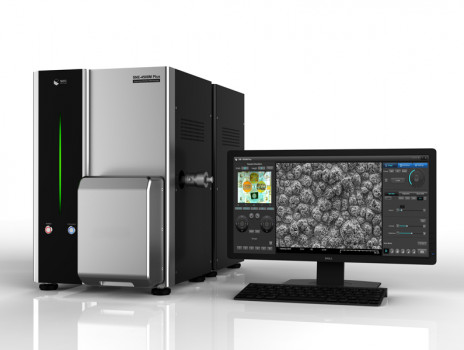Scanning Electron Microscope

|
In August of 2019, Rebecca Schindler , Professor of Classical Studies and Director of the Trasimeno Archaeological Project, Jim Mills, Professor of Geosciences, and their student Wilson Wolf (DePauw [DPU] ’20) used the Scanning Electron Microscope (SEM) for analysis of pottery sherds from the Italy-based Trasimeno Archaeological Project. |
|
Professor Lafontant (PI, BBIC): In year two of the BBIC grant period, independent research students from the Lafontant Lab made extensive use of the BBIC to further their research. These students included Emma Nelson (DPU ’20), Alyssa Koch (DPU ’21), Kobby Van Dyck (DPU ’20), Kamil Hester (DPU ’20), Eric Spehlmann (DPU ’21), Victor Alfonso (DPU ’20). Among their achievements were the completion of various projects, many of which became scientific abstracts that were submitted to regional and national scientific meetings. |
|
Professor Philips Akinwole and his student Vivica Cook (DPU ’21) are interested in the phenotype of the white clover leaf that is positive for the presence of cyanogenic glycoside in its leaves. Their goal was to image plants and find potential structural differences that correlate with the glycoside production. Because they are focused on imaging plant material, they had to trial different methods of preparation of the material for the SEM. Plants have a cell wall that has different chemical properties than other organisms, which makes it more tedious to prepare for SEM. Plants also have a lot of waxy material on their leaves, which is destroyed in the standard dehydration and fixation procedures that most tissues have to go through in order to be imaged by the SEM. Vivica began trialing different procedures to prepare the plant leaves that were referenced in papers that she researched. She was still working on the procedure when DePauw broke for COVID-19 in March of 2020. |
|
Professor Dana Dudle is a plant biologist who has an interest in cultivars of common plants. In the academic year 2018-2019, she spent her sabbatical time at the Chicago Botanic Garden studying cultivars that have been bred, by plant lovers over generations, to have the characteristics that they desire. Victor Alfonso (DPU ’20) a biology student became very interested in the imaging capabilities of the SEM and wanted to produce more images. He partnered with Professor Dudle. She collected samples of her cultivars, and Wendy Tomamichel processed the samples, and Victor began imaging them. His work was cut short due to COVID-19. |
|
Dr. Ken Brown (DePauw Geosciences) joined the BBIC in fall 2019. He is a postdoctoral scholar and assistant professor of Geosciences. His research and teaching expertise include the fields of mineralogy, petrology, and environmental geology. Professor Brown also has a background in advanced analytical instrumentation and technology that includes SEM and EDS, X-ray Fluorescence (XRF), X-ray Diffraction (XRD), and Electron Probe Micro-Analysis (EPMA). During his first year at DePauw, Professor Brown integrated the BBIC facilities into his courses, namely Mineralogy (fall 2019) and Petrology (spring 2020). Additionally, Dr. Brown developed four (4) student-faculty collaborative summer research projects with undergraduate students (Hannah Baker DPU ’21; Abby Cooke DPU ’22; Kelby Stallings DPU ’22; and Laura Spasske DPU ’21). Aspects of these projects were aimed at leveraging the BBIC facilities to investigate mineral microstructures and to characterize the chemical composition of soil and sediment particles. Due to COVID-19, however, these projects were canceled for summer 2020. |